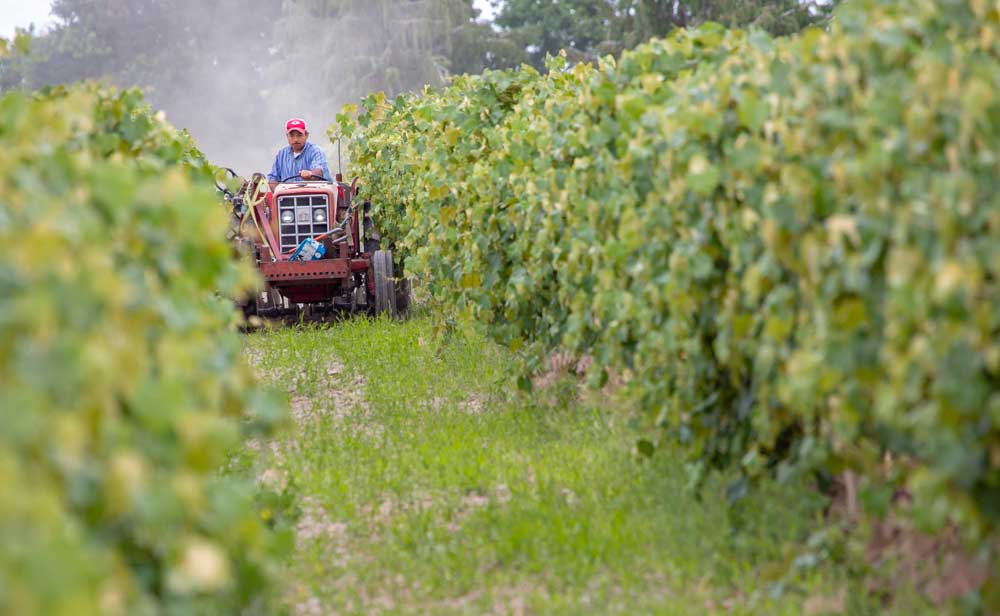
Sergio Berduzco disks between concord grape rows near Sunnyside, Washington, in 2016. Results from a multiyear study from Michigan State University offer strategies to help Concord growers maximize mechanization and increase productivity.
(TJ Mullinax/Good Fruit Grower)
Washington may be king when it comes to tonnage of Concord grapes for juice, but people from the Great Lakes region know their grape juice as well. And although the whole grapes are becoming harder to find at roadside stands, intrepid Concord lovers always seem to track down a few clusters of the pulpy-skinned fruits during their short fall harvest time.

Mark Longstroth
“Any time you’re dealing with processing fruit, no matter what kind, you have competition from other growing regions in the world that can produce stuff more cheaply than you can,” said Mark Longstroth, Michigan State University’s small fruit educator, who is among the researchers working to make the crop more profitable for growers.
In the early 1990s, Concord growers were getting about $350 a ton for their grapes, compared to approximately $200 a ton today, he said.
“With costs at about $1,500 an acre to prune, spray and harvest them, and figuring an average of 6 tons per acre, that means they’re losing about $300 on every acre they harvest.” Many growers responded to the decreased profits by curtailing inputs to their vineyards, he said, but this only serves to decrease yields and profits further and leads to a “death spiral.”
Fortunately, growers have better options. Results from the Michigan State University “Vineyard of the Future” study showed that new training systems, mechanization and grafted vines can all boost profits by either cutting costs or increasing productivity.
Conceived by recently retired MSU Department of Horticulture Professor Tom Zabadal, the study tested several strategies of mechanical pruning and shoot positioning on a 5-acre experimental vineyard, which was planted in 2011 at the MSU Southwest Michigan Research and Extension Center.
Longstroth, who is now reporting the results of the Vineyard of the Future study, said it was designed to showcase strategies to maximize mechanization and increase productivity.
Here’s a rundown:
—Mechanical pruning: Mechanical pruning is less expensive than hand pruning the vines, but growers should do a bit of follow-up hand pruning, Longstroth said. “Machines save a lot of time, but they don’t do a good job of everything, so if you don’t do some hand pruning afterward to clean things up, you generally end up with a disease problem down the road,” he said.
—Mechanical shoot positioning: Zabadal developed a shoot positioner that opens the canopy. It is used soon after bloom, when the shoots are a couple of feet long and just starting to settle down.
“The shoot positioner has fingers that rip the vines off the top of the trellis and orient them perpendicular to the trellis,” said Longstroth, “so instead of all the shoots growing one on top of another and shading each other out, they’re all growing next to each other, which opens up the canopy and allows for better spray penetration for pesticides and better light penetration for maturing wood,”
In the 10 years since Zabadal developed it, more people have gone to mechanical pruning and, once they do that, many are also trying mechanical shoot positioning. “After all, you need to pull the running brush off the trellis to prune it, (so) why not do it in the growing season and get the benefit then?” Longstroth said.
—Raising the height of the vineyard: With the advent of mechanical pruning and shoot positioning, the cordon height no longer needs to be limited to a worker’s shoulder height. That opened the possibility of adding a second, higher trellis wire at 7 feet so the vine had four cordons: two at 5 feet and two more at 7 feet.
The two-tier, four-arm system bested traditional single-tier, two-arm systems year after year, showing yields that were 50 percent higher than the state average.
Brix levels were initially lower in new-system vineyards but improved over time. “We got to the point where we could always make minimum sugar on that vineyard,” he said. Commercial harvest of the high-trellis vineyard averaged 17.1 degrees Brix in 2016 and 15.0 to 15.8 degrees Brix in 2017.
—Trying different rootstocks: In comparing rootstocks, they found grafted vines consistently outproduced own-rooted Concords by 1 to 2 tons per acre. “It wasn’t a statistically significant improvement, but it was always there,” he said.
In other words, it wasn’t enough of a difference to recommend replacing an own-rooted vineyard, but it’s something to think about when planting new vines.
Performance of the different grafted rootstocks varied from year to year, so the data showed no clear winner.
Of all of the strategies, higher trellises have drawn the most attention among growers, Longstroth said.
“Nobody is doing the raised trellis yet, but they’re all really interested in it,” he said. “Raising the trellis to 7 feet by replacing the posts and moving the existing vines onto the top wire certainly looks like a worthwhile way to go long term.” •
—by Leslie Mertz






Leave A Comment